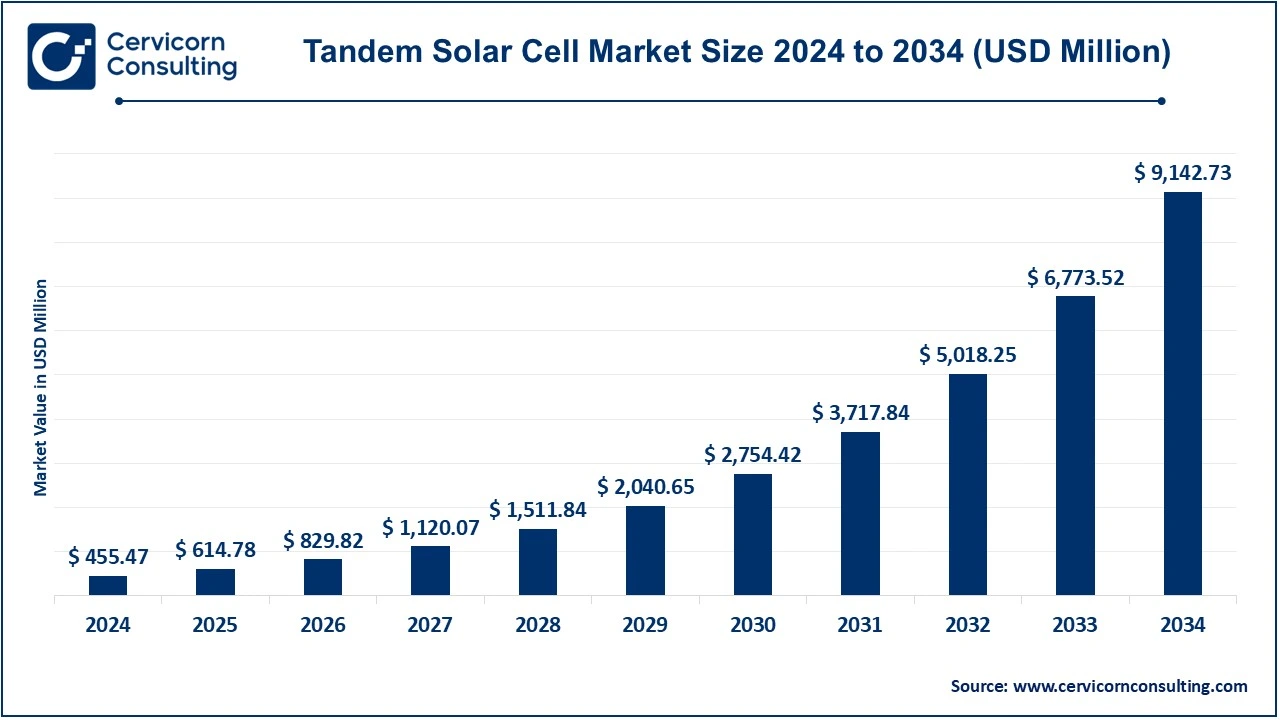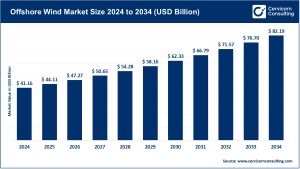Tandem Solar Cell Market Overview
The global tandem solar cell market represents a pivotal advancement in photovoltaic (PV) technology, offering higher efficiency and better performance than conventional single-junction cells. According to Cervicorn Consulting, the market was valued at USD 1.92 billion in 2024 and is projected to reach approximately USD 9.56 billion by 2034, expanding at a robust CAGR of 17.38% during 2025–2034. This strong growth trajectory reflects rising investment in renewable energy, government-backed solar adoption programs, and increasing demand for efficient, cost-effective solar power solutions.
Tandem solar cells—combining multiple semiconductor materials to capture a broader spectrum of sunlight—are at the forefront of next-generation PV innovation. They promise superior energy conversion efficiency, with potential rates exceeding 30%, making them a key enabler of sustainable energy transition globally.
Key Market Trends
1. Rapid Advancements in Perovskite-Silicon Tandem Technology
The integration of perovskite with silicon-based cells is revolutionizing solar efficiency. Companies like Oxford PV have achieved record-breaking conversion efficiencies above 28%, marking a critical step toward commercial-scale deployment. Continuous R&D investments are enhancing the scalability, stability, and durability of these hybrid cells, paving the way for mass production by 2026–2027.
2. Growing Emphasis on Flexible and Lightweight Solar Modules
Manufacturers such as Heliatek and Peccell Technologies are pioneering ultra-thin, flexible tandem cells for applications in building-integrated photovoltaics (BIPV) and consumer electronics. These innovations allow for energy generation on non-traditional surfaces like windows, facades, and vehicles—broadening the scope of solar energy deployment beyond rooftops.
3. Increased Focus on Sustainability and Recyclability
With global environmental policies tightening, companies are shifting toward eco-friendly materials and low-carbon manufacturing processes. The European Union and Asia-Pacific nations are incentivizing the adoption of recyclable solar modules, further driving tandem cell innovation.
4. Integration with Energy Storage and Smart Grid Solutions
Tandem solar technologies are being paired with advanced battery systems and AI-enabled energy management to improve efficiency and grid reliability. Firms such as Trina Solar and LONGi Solar are integrating smart energy platforms to optimize power generation and consumption in real time.
5. Rising Investments and Strategic Collaborations
Major players and research institutions are entering into strategic alliances to accelerate commercialization. For example, First Solar and Q CELLS have expanded R&D partnerships to explore scalable manufacturing processes, while governments in China, the U.S., and Europe are allocating subsidies for next-generation PV pilot projects.
Get a Free Sample: https://www.cervicornconsulting.com/sample/2560
Market Drivers
1. Increasing Global Energy Demand and Decarbonization Goals
The global shift toward net-zero emissions is a major catalyst. According to IEA projections, renewable energy capacity is expected to grow by over 60% between 2024 and 2030, with solar PV accounting for the majority. Tandem cells, offering up to 40% higher efficiency, are vital in meeting these ambitious clean energy goals.
2. Supportive Government Policies and Incentives
Subsidies, feed-in tariffs, and tax credits are propelling investment in tandem solar technology. For instance, the U.S. Inflation Reduction Act (IRA) and the European Green Deal have significantly boosted funding for advanced photovoltaic R&D and domestic production, spurring market competitiveness.
3. Technological Advancements Reducing Costs
Continuous improvements in manufacturing scalability, material durability, and module design are driving cost reductions. The per-watt cost of tandem solar modules is projected to drop by 25–30% by 2028, making them competitive with conventional PV systems.
4. Rising Adoption in Commercial and Industrial (C&I) Applications
Corporates are increasingly adopting tandem solar installations for energy independence and carbon footprint reduction. The commercial sector currently accounts for around 35% of market share, with significant growth anticipated in logistics, manufacturing, and construction industries.
5. Expanding Research Funding and Private Investment
Venture capital and institutional funding in tandem solar startups reached USD 1.1 billion globally in 2024, highlighting rising investor confidence. Emerging economies such as India and Southeast Asia are also fostering domestic R&D initiatives to localize production.
Impact of Trends and Drivers
-
Residential Segment: Enhanced efficiency and falling module prices are making tandem solar systems more affordable for households, particularly in regions with high solar irradiance like India, Australia, and the Middle East.
-
Commercial Sector: Corporates are integrating tandem PV with smart grids and battery systems to meet sustainability mandates.
-
Regional Influence:
-
Asia-Pacific dominates due to strong manufacturing bases in China, Japan, and South Korea.
-
Europe is leading in innovation and pilot testing, supported by stringent environmental regulations.
-
North America is witnessing increasing installations due to policy incentives and tech collaborations.
-
Challenges and Opportunities
Challenges
-
High initial production costs and limited large-scale manufacturing infrastructure.
-
Stability issues with perovskite materials under prolonged exposure to environmental factors.
-
Need for standardized testing and certification frameworks for tandem modules.
Opportunities
-
Integration with BIPV and floating solar applications.
-
Expanding demand for green hydrogen production via solar-powered electrolysis.
-
Emergence of AI-driven energy optimization systems enhancing performance monitoring and efficiency.
Future Outlook
The tandem solar cell market is poised for exponential growth as the energy industry transitions toward sustainability. By 2034, the market is expected to reach USD 9.56 billion, driven by technological breakthroughs, supportive policy environments, and escalating renewable energy targets worldwide.
Continuous innovation in perovskite-silicon and CIGS-perovskite combinations will enhance conversion efficiencies and lower costs, solidifying tandem solar cells as a mainstream renewable energy solution across sectors.
In the coming decade, Asia-Pacific and Europe will remain the primary growth hubs, while emerging markets in Africa and Latin America are anticipated to adopt tandem technologies rapidly due to favorable solar conditions and cost declines.
Overall, the tandem solar cell market embodies the future of sustainable, high-efficiency energy generation—driven by innovation, investment, and the global pursuit of carbon neutrality.


